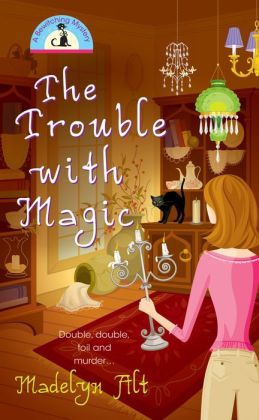
The Trouble with Magic
By Madelyn Alt
3 Covers out of 5
This first book in the Bewitching Mystery series begins with
Maggie O’Neill, lifetime resident of Stony Mills, Indiana (population 6,000+),
literally stumbling into a new job at the gift shop Enchantments just in time
for the owner and sole other employee, Felicity, to be accused of murdering her
sister. Sadly, these sorts of
coincidences abound as Maggie endeavors to solve the crime while battling the
police dept.’s prejudice towards Felicity as a self-proclaimed New Age
witch. The mystery itself is rote, with
red herrings barely registering against the obvious culprit. But the story is enhanced through the use of
the supernatural, even though it has absolutely no bearing on the case.
The author does a good job establishing the small town
setting, showing it to have a diverse culture as a growing suburb, even though
there is an element of the Catholic majority being closed-minded. But the author has also perhaps read too many
mystery novels as the story treads a well-established trail, though sometimes
using lazy shortcuts to achieve her ends.
A particular stand out of this is the scene where Maggie informs the
reader (the story is told in first person) that people have always felt they
could confide in her, just in time for someone to confide a large amount of
exposition that probably could not have fit in neatly any other way. Of course, in the same scene Maggie declares
that she is a good judge of character, despite the reader having already seen
her misjudge two characters already.
Part of the problem is Maggie herself. She is not a dynamic character, spending much
of the story reacting rather than acting.
And quirks that are supposed to be endearing come off more as pathetic,
such as her obsession with the television show Magnum PI, which somehow does
not extend to owning the DVDS. The story
does pick up in the last third when she begins to actively solve the case, even
if she doesn’t act within the full level of her intelligence.
Now, as I have pointed out what I see to be several flaws in
the storytelling, it may seem like I should give the book a lower score. While the mystery itself is average, I come
back to the supernatural element which sets the story apart from other
mysteries, especially the hint that there is something sinister going on in Stony
Mills to be dealt with in future books. I
wish the supernatural had been more key to the mystery itself, but I will take
what I can get.


